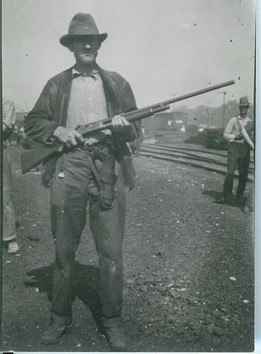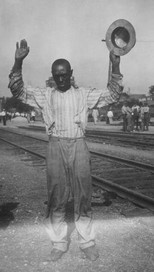The Tulsa Race Riot of 1921
Introduction
Text-to-speech Audio
Images
A white man poses with his rifle during the riot. He may have been part of the mob, or he may have been part of the deputized police force raised among the city's white male population.

Mt. Zion Baptist Church in the aftermath of the riot

A street in the Greenwood neighborhood after the riot

An unarmed Black resident of the city surrenders to police during the event known as the Tulsa Race Riot.

Backstory and Context
Text-to-speech Audio
Dick Rowland was a nineteen-year-old man employed at the Drexel to shine the shoes of white guests. Rowland was only allowed to use the restroom at the top floor of the building owing to racial segregation. While using the elevator operated by Sarah Page in order to use the restroom, he was accused of grabbing Page's arm. The event was investigated by police, who concluded that it was unlikely that Rowland had grabbed her arm with the intention of assaulting her on the elevator. Page appears to have agreed with the police investigation as she declined to press charges.
Despite the fact that both Page and the police concluded that her initial fears of Rowland were unjustified, racial prejudice had already been stoked to high levels in response to white fears of the growing and increasingly wealthy Black community of Tulsa. In this climate of paranoia and prejudice, wild stories were circulated by white residents. These stories sold newspapers, leading to and sensationalist reports in each of the city's leading publications.
In response to an anonymous tip that Rowland's life was in danger, the police chose to detain Rowland in the Tulsa County Courthouse for his safety.By sunset, several hundred white men had gathered, presumably to demand that Rowland be released to their custody so they could lynch him rather than allow him to be released or even stand trial for a crime the police and Page agreed had not occurred.
The sheriff attempted to keep the men out of the courthouse, but several armed white men forced their way into the building and demanded that Rowland be handed over to them. The sheriff understood the consequences and was willing to risk his life to protect Rowland. He and his deputies turned the men away and faced the growing mob, even as he and his men were outnumbered and outgunned.
The sheriff might have accepted the assistance of Black veterans, but instead rebuked these offers, believing that the threat would soon subside. In response, members of the Black community--only a few blocks away from the courthouse--were determined to prevent the lynching of another member of their community. Veterans of World War I began gathering guns and ammunition to confront the mob at the courthouse. Close to thirty men who were armed with rifles and shotguns made their way to the courthouse. These men offered to help the deputies protect Rowland. The sheriff, however, ordered the Black men to leave, believing that this might diffuse the increasingly tense atmosphere.
When the white mob realized that there were armed Black men approaching them, approximately 1,000 white men fled the area. However, they soon returned with larger numbers and more guns. Some white residents even attempted to capture the National Guard armory to obtain more weapons. However, the guardsmen refused to be swayed by the mob and maintained the integrity of their armory. Soon these citizen soldiers would be called on to restore order.
By evening, the white mob had grown to over 2,000. A small small group of armed Black returned to the courthouse to demonstrate their resolve to protect Rowland. From the perspective of white residents, who believed that Black men had committed many outrages against white women in other cities, Rowland was guilty and failure on their part to make an "example" out of him would threaten the lives and honor of "their" women. The arrival of armed Black men at the courthouse in this racially-charged atmosphere seemed only to confirm reports of a coming race war. Whites who called for calm and asked that the police be allowed to control the situation were met with threats.
When shots were fired, it seemed to many as if a race war was inevitable. Reports that thousands of Black men were converging on Tulsa were circulated and inspired many white residents to believe that their families were in danger. After white mobs began shooting at Black residents and burning homes and churches, officials declared martial law. The all-white members of the Oklahoma National Guard who were deployed to quell the riot helped to restore order, but they also tended to sympathize with the white mob. In the coming days, four to five thousand Blacks were arrested and held for days. No white rioters were arrested, even those who shared photographs demonstrating their guilt. In fact, thousands of white men openly boasted of setting Black homes on fire, believing that these actions proved that they alone had the mettle to protect their families, wives, and white neighbors.
At least 36 African Americans were killed in the riot, while hundreds more were missing. Precise estimates of the carnage are impossible, as the hundreds missing were either dead or simply fled the city by any means possible. The fires caused an estimated $1.5 million in property damage, and left thousands of Black residents homeless. After the riot, hundreds of additional Black residents fled the city, both owing to fear and necessity after losing their homes. A total of 30 to 300 Black people were killed in the riots and at least 800 were injured in some fashion. The riots also led to the deaths of ten to twenty white resident.For many years, the City of Tulsa denied any culpability in the riots. Despite the findings of historians and a special commission whose 2001 report is attached to this entry, no efforts have been made by the city, state, or national government to compensate the victims of the riots.
